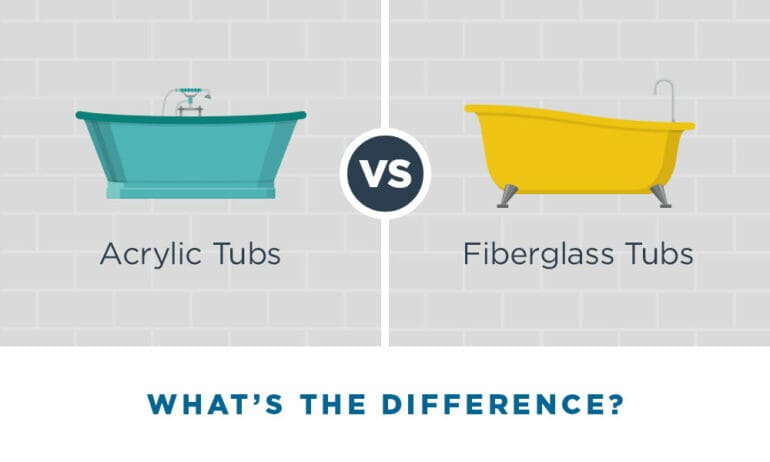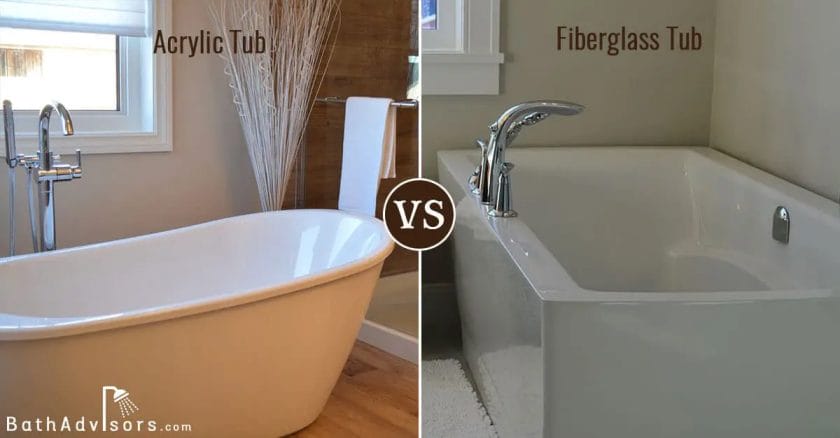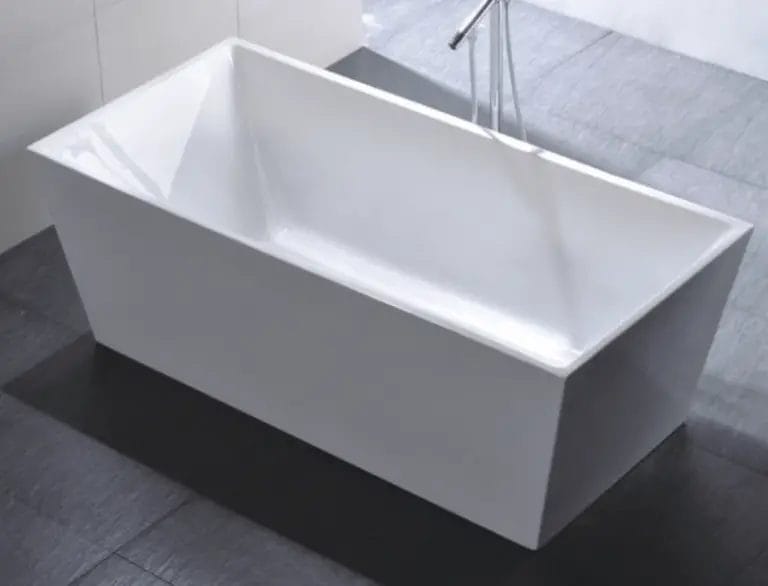If you’re wondering whether your bathtub is made of fiberglass or acrylic, there are a few telltale signs that can help you determine the material. Firstly, fiberglass tubs usually have a rougher texture and may feel slightly flexible when pressed. On the other hand, acrylic tubs tend to have a smoother surface and feel more rigid. Additionally, fiberglass tubs are typically lighter in weight compared to acrylic tubs. By closely examining the texture, flexibility, and weight of your bathtub, you can easily identify whether it is fiberglass or acrylic.

Key Differences Between Fiberglass and Acrylic Bathtubs
When it comes to choosing a new bathtub for your bathroom, there are several options available in the market. Two popular choices are fiberglass and acrylic bathtubs. Both materials have their own unique properties and advantages. In this section, we will explore the key differences between fiberglass and acrylic bathtubs to help you make an informed decision.
1. Material Composition
Fiberglass bathtubs are made from layers of fiberglass reinforced with a polyester resin. This combination creates a strong and durable bathtub that is resistant to chipping and cracking. On the other hand, acrylic bathtubs are made from sheets of acrylic that are reinforced with fiberglass. The acrylic material provides a smooth and glossy finish to the bathtub.
2. Appearance
When it comes to appearance, acrylic bathtubs have an edge over fiberglass bathtubs. Acrylic is a highly versatile material that can be molded into various shapes and designs. It also retains its color and glossiness over time. Fiberglass bathtubs, on the other hand, may fade or discolor over time, especially if exposed to direct sunlight.
3. Durability
Both fiberglass and acrylic bathtubs are durable and can withstand regular use. However, fiberglass bathtubs are more prone to scratching and cracking compared to acrylic bathtubs. Acrylic is a non-porous material, which makes it resistant to stains and easier to clean. Fiberglass bathtubs, on the other hand, may require more maintenance to keep them looking their best.
4. Installation
Installing a fiberglass or acrylic bathtub is a relatively straightforward process. Both materials are lightweight, making them easy to transport and maneuver during installation. However, acrylic bathtubs are slightly heavier than fiberglass bathtubs, which may require additional support during installation. It is important to hire a professional plumber or contractor to ensure proper installation and prevent any issues in the future.
5. Cost
When it comes to cost, fiberglass bathtubs are generally more affordable than acrylic bathtubs. Fiberglass is a cost-effective material that is widely available in the market. Acrylic bathtubs, on the other hand, tend to be more expensive due to the higher cost of materials and production. However, the price difference may vary depending on the brand, design, and features of the bathtub.
6. Maintenance
In terms of maintenance, fiberglass bathtubs may require more attention compared to acrylic bathtubs. Fiberglass surfaces can be prone to staining and may require regular cleaning with non-abrasive cleaners to maintain their appearance. Acrylic bathtubs, on the other hand, are easy to clean and maintain. They can be wiped down with a mild soap and water solution to keep them looking new.
7. Longevity
Both fiberglass and acrylic bathtubs can have a long lifespan if properly maintained. However, acrylic bathtubs are known to have better longevity compared to fiberglass bathtubs. The acrylic material is more resistant to wear and tear over time, making it a more durable option.
In summary, fiberglass and acrylic bathtubs have their own unique qualities and advantages. Fiberglass bathtubs are more affordable and lightweight, but may require more maintenance. Acrylic bathtubs, on the other hand, are visually appealing, durable, and easier to clean. Consider your budget, preferences, and maintenance requirements before making a decision on which type of bathtub to choose for your bathroom.
Visual Cues to Identify Fiberglass or Acrylic Bathtubs
If you are in the market for a new bathtub, it’s important to know the differences between fiberglass and acrylic tubs. While they may look similar at first glance, there are some visual cues that can help you identify whether a tub is made of fiberglass or acrylic. Let’s take a closer look at these visual cues:
1. Surface Texture
One of the first things you can look at to identify the material of a bathtub is the surface texture. Fiberglass tubs typically have a slightly rough or textured surface. This can be seen and felt when you run your hand across the surface of the tub. On the other hand, acrylic tubs have a smooth and glossy surface that feels more like plastic.
2. Color Consistency
Another visual cue to consider is the color consistency of the bathtub. Fiberglass tubs tend to have a more uniform color throughout the entire surface. This means that if you were to scratch or chip the tub, the color underneath would be the same as the top layer. Acrylic tubs, on the other hand, often have a color or pattern applied to the surface. If you were to scratch an acrylic tub, the color or pattern may be different underneath.
3. Weight
The weight of the bathtub can also provide a clue as to whether it is made of fiberglass or acrylic. Fiberglass tubs are generally heavier than acrylic tubs. If you are able to lift or move the tub, you may notice that a fiberglass tub feels heavier and more solid compared to an acrylic tub, which is often lighter and more flexible.
4. Flexibility
Speaking of flexibility, this is another visual cue that can help you differentiate between fiberglass and acrylic tubs. Acrylic tubs are known for their flexibility and ability to be molded into various shapes and sizes. If you press your hand against the side of an acrylic tub, you may notice a slight give or flex. Fiberglass tubs, on the other hand, are more rigid and less flexible.
5. Thickness
The thickness of the bathtub can also indicate whether it is made of fiberglass or acrylic. Fiberglass tubs tend to be thicker and have a more substantial feel. Acrylic tubs, on the other hand, are generally thinner and lighter in weight. By comparing the thickness of different tubs, you may be able to determine the material.
By paying attention to these visual cues, you can easily identify whether a bathtub is made of fiberglass or acrylic. From the surface texture and color consistency to the weight, flexibility, and thickness, these visual cues provide valuable information that can help you make an informed decision when choosing a new bathtub for your home.
Tapping Test: How to Determine the Material of Your Bathtub
When it comes to bathtubs, there are various materials used such as acrylic, fiberglass, enamel, and cast iron. Knowing the material of your bathtub is essential for proper maintenance and repair. One simple and effective way to determine the material of your bathtub is by performing a tapping test. In this section, we will guide you through the steps of conducting a tapping test to identify the material of your bathtub.
Step 1: Gather the Necessary Tools
Before you begin the tapping test, make sure you have the following tools:
- A rubber mallet or a wooden spoon
- A towel or a piece of cloth
Step 2: Choose a Suitable Spot
Select a spot on your bathtub where you can easily access and tap without causing any damage. It is recommended to choose an inconspicuous area such as the side or the bottom of the tub.
Step 3: Tap the Surface
Take the rubber mallet or the wooden spoon and gently tap the chosen spot on your bathtub. Pay attention to the sound and the vibration produced by the tap.
Step 4: Analyze the Results
Based on the sound and the vibration, you can determine the material of your bathtub:
- Acrylic: If the tap produces a hollow and high-pitched sound with minimal vibration, it is likely that your bathtub is made of acrylic. Acrylic tubs are lightweight and have a smooth, non-porous surface.
- Fiberglass: If the tap produces a dull and low-pitched sound with moderate vibration, your bathtub is likely made of fiberglass. Fiberglass tubs are also lightweight and have a slightly flexible surface.
- Enamel: If the tap produces a high-pitched sound with a metallic ring and minimal vibration, your bathtub is likely enamel-coated. Enamel tubs are durable and have a glossy finish.
- Cast Iron: If the tap produces a deep, resonant sound with little to no vibration, your bathtub is most likely made of cast iron. Cast iron tubs are heavy and have a sturdy, luxurious feel.
In summary, by performing a tapping test on your bathtub, you can easily determine the material it is made of. This knowledge will help you in choosing the right cleaning and maintenance products, as well as understanding any repair or refinishing requirements specific to your bathtub material.
Pros and Cons of Fiberglass and Acrylic Bathtubs
Choosing the right bathtub for your bathroom can be a daunting task. With so many options available in the market, it’s important to consider the pros and cons of different materials. Two popular choices for bathtubs are fiberglass and acrylic. Let’s explore the advantages and disadvantages of each:
1. Fiberglass Bathtubs
Fiberglass bathtubs have been a popular choice for many homeowners due to their affordability and durability. Here are some of the pros and cons of fiberglass bathtubs:
Advantages:
- Affordability: Fiberglass bathtubs are generally more budget-friendly compared to other options in the market. If you’re on a tight budget, fiberglass bathtubs can be a cost-effective choice.
- Lightweight: Fiberglass is a lightweight material, making it easier to install and transport. This can be beneficial if you plan on DIY installation or need to replace the bathtub in the future.
- Easy to Clean: Fiberglass bathtubs are smooth and non-porous, making them resistant to stains and easy to clean. Simply wipe them down with a mild cleaner and a soft cloth.
Disadvantages:
- Prone to Scratches: Fiberglass can be susceptible to scratches and cracks over time. Avoid using abrasive cleaners or scrubbing with harsh materials to maintain the bathtub’s appearance.
- Limited Design Options: Fiberglass bathtubs often come in limited design options compared to other materials, which may restrict your choices when it comes to aesthetics.
- Less Heat Retention: Fiberglass bathtubs may not retain heat as effectively as other materials, which can result in the water cooling down faster during longer baths.
2. Acrylic Bathtubs
Acrylic bathtubs are another popular choice among homeowners due to their versatility and durability. Let’s take a look at the pros and cons of acrylic bathtubs:
Advantages:
- Wide Range of Designs: Acrylic bathtubs come in a wide variety of designs, shapes, and sizes, allowing you to find the perfect fit for your bathroom’s aesthetics.
- Durability: Acrylic is a highly durable material that resists chipping, cracking, and fading over time. It can withstand daily use without losing its luster.
- Heat Retention: Acrylic bathtubs retain heat better than fiberglass, providing you with a longer and more enjoyable bathing experience.
Disadvantages:
- Cost: Acrylic bathtubs are generally more expensive compared to fiberglass options. If budget is a constraint, you may need to consider other alternatives.
- Weight: Acrylic bathtubs are heavier than fiberglass, which can make installation more challenging. It’s recommended to hire a professional for installation.
- Prone to Scratches: While acrylic is more durable than fiberglass, it can still be vulnerable to scratches and cracks. Care must be taken when cleaning and using the bathtub to avoid damage.
Summary
When choosing between fiberglass and acrylic bathtubs, it’s important to consider your budget, design preferences, and maintenance requirements. Fiberglass bathtubs are a more affordable and lightweight option, but they may be prone to scratches and offer limited design options. Acrylic bathtubs, on the other hand, provide a wide range of designs, excellent heat retention, and durability, but they come at a higher cost and require professional installation. Ultimately, the decision will depend on your individual needs and preferences.
Expert Tips for Identifying Fiberglass or Acrylic Bathtubs
If you’re in the market for a new bathtub, it’s important to understand the differences between fiberglass and acrylic options. Both materials offer their own set of advantages and disadvantages, so being able to identify which type of bathtub you’re looking at can help you make an informed decision. In this section, we will provide you with expert tips for identifying fiberglass or acrylic bathtubs.
1. Look for visual clues
One of the easiest ways to identify the type of bathtub is by looking for visual clues. Fiberglass bathtubs typically have a textured surface that resembles a crosshatch pattern or small dimples, while acrylic bathtubs have a smooth, glossy finish. You can run your hand over the surface to feel the texture and determine if it’s fiberglass or acrylic.
2. Check the weight
Fiberglass bathtubs are generally lighter in weight compared to acrylic bathtubs. If you’re able to lift the bathtub or have access to the specifications, you can compare the weight to get an idea of the material. Fiberglass bathtubs are lighter and easier to install, while acrylic bathtubs are heavier and may require additional support.
3. Tap the surface
Another way to distinguish between fiberglass and acrylic bathtubs is by tapping the surface. Fiberglass bathtubs tend to have a hollow sound when tapped, while acrylic bathtubs produce a solid and dense sound. This simple test can help you determine the material by sound alone.
4. Look for flex
Fiberglass bathtubs have a slight flex or give when pressure is applied, while acrylic bathtubs are more rigid and do not flex as easily. Gently pressing on the sides or bottom of the bathtub can give you an idea of the material’s flexibility. However, be cautious not to apply excessive force or damage the bathtub in the process.
5. Check for scratches
Acrylic bathtubs are prone to scratches, while fiberglass bathtubs are more resistant. If you notice any scratches on the surface, it’s likely an acrylic bathtub. Fiberglass bathtubs, on the other hand, can withstand more wear and tear without showing visible signs of damage.
6. Consult a professional
If you’re still unsure about the material of a bathtub, it’s always best to consult a professional. A plumber or bathroom specialist can easily identify the type of bathtub based on their experience and knowledge. They can also provide guidance and recommendations based on your specific needs and preferences.
By using these expert tips, you can confidently identify whether a bathtub is made of fiberglass or acrylic. Understanding the material can help you make a well-informed decision when it comes to choosing the right bathtub for your bathroom renovation or new construction project.

FAQs
1. How can I tell if a bathtub is fiberglass or acrylic?
To determine if a bathtub is fiberglass or acrylic, you can do a simple test. Gently tap on the tub’s surface with your knuckles. If it sounds hollow, it’s most likely fiberglass. If it produces a solid, dull sound, it’s probably acrylic. Additionally, fiberglass tubs are usually lightweight, while acrylic tubs tend to be heavier.

Conclusion:
In conclusion, identifying whether a bathtub is made of fiberglass or acrylic can be important for maintenance and repair purposes. By considering various factors, such as the texture, weight, and flexibility of the material, it is possible to make an accurate determination. Additionally, inspecting any manufacturer labels or markings can provide valuable information about the bathtub’s construction. If uncertain, seeking professional assistance from a plumber or a bathtub specialist can help ensure an accurate identification. Remember, correctly identifying the material will aid in properly caring for and maintaining your bathtub to ensure it lasts for years to come.
